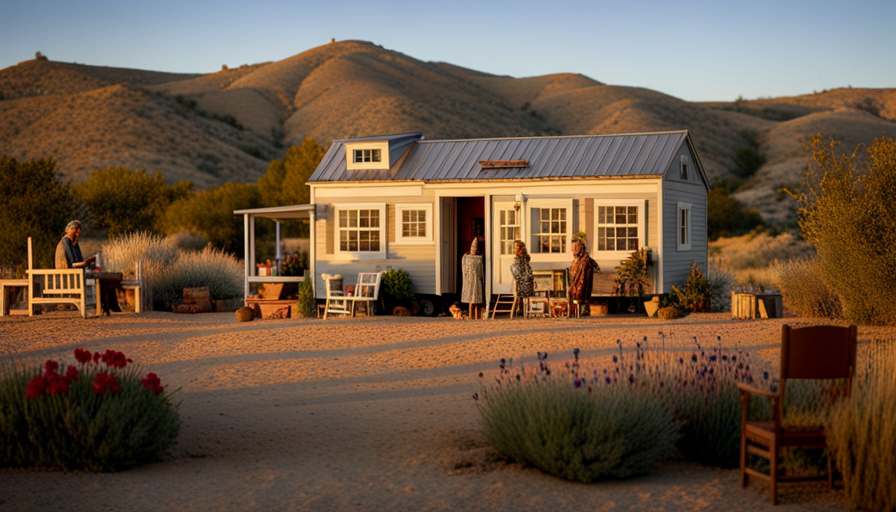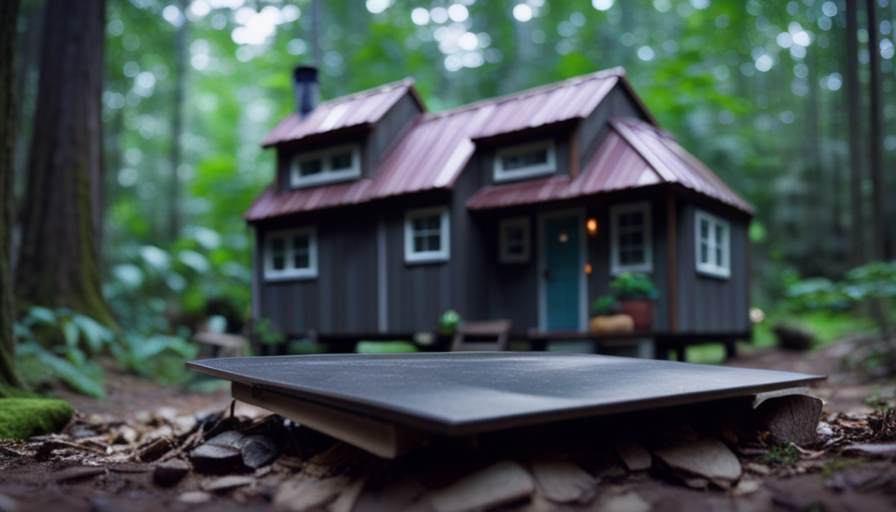Are you tired of constantly feeling stressed out by the mess in your home? We’ve all experienced that feeling. But don’t worry, we’re here to help you embark on a path to a clutter-free and more mindful way of living.
In this article, we’ll share practical tips and strategies to help you declutter your home with ease. By embracing minimalism and developing sustainable habits, you’ll not only create a serene environment but also serve yourself and others by donating unwanted belongings.
Let’s get started on this transformative journey together.
Key Takeaways
- Adopting a decluttering mindset that values simplicity and intentionality is essential.
- Organizing belongings into specific categories and assessing what is truly needed helps in creating a more peaceful and organized living space.
- Efficient techniques such as categorizing items and optimizing space utilization save time and reduce stress.
- Removing and donating unwanted items not only clears space but also benefits others and the environment.
Assess the Clutter
Let’s take a moment to assess the clutter in our homes. As we embark on our journey towards minimalism, it’s crucial to have a clear understanding of our starting point. Assessing the clutter allows us to gauge our progress and set realistic goals.

To begin, we need to adopt a decluttering mindset – one that values simplicity and intentionality. It’s about embracing the idea that less is more and focusing on what truly matters.
As we assess each area of our home, let’s ask ourselves some practical questions: Do we use this item regularly? Does it bring us joy? Is it serving a purpose in our lives?
Sort by Categories
When it comes to decluttering our homes, sorting by categories is a key step in the process. By organizing our belongings into specific categories, such as clothing, books, and kitchen items, we can more efficiently assess what we’ve and what we truly need.
This method allows us to see the bigger picture and make more informed decisions about what to keep, donate, or discard. Plus, the benefits of decluttering are numerous, from creating a more peaceful and organized living space to reducing stress and increasing productivity.

Efficient Organization Techniques
We can achieve efficient organization by sorting our belongings into categories. By categorizing our items, we can optimize our space utilization and save time when searching for specific things. Here are three effective organization techniques to consider:
| Category | Example Items | Benefits |
|---|---|---|
| Clothing | Shirts, pants, dresses | Easier to find and select outfits |
| Kitchenware | Utensils, pots, pans | Faster meal preparation and cleanup |
| Electronics | Chargers, cables, gadgets | Quick access to necessary devices |
Sorting our belongings into categories allows us to create designated spaces for each group, making it easier to locate and maintain our possessions. This efficient organization technique not only saves us time and effort but also brings a sense of order and clarity to our living environment. With our belongings neatly organized, we can now explore the benefits of decluttering.
Benefits of Decluttering
By categorizing our belongings and decluttering by sorting them into categories, we can experience numerous benefits in our living environment.
One of the main benefits of minimalism is the psychological effect it has on our minds. Decluttering helps reduce stress and anxiety by providing a sense of clarity and order in our surroundings. It allows us to focus on what truly matters and creates a peaceful and calm atmosphere in our homes.

Additionally, decluttering by categories helps us to easily locate and access our belongings, saving us time and frustration. By eliminating unnecessary items, we open up space for more meaningful experiences and relationships. Removing the excess clutter allows us to create a home that’s functional, efficient, and conducive to our well-being.
Remove Unnecessary Items
Let’s start by going through our belongings and getting rid of any unnecessary items. Removing unnecessary items is an essential step in decluttering our homes and creating a more peaceful living space. Here are four practical tips to help you in this process:
-
Assessing Progress: Begin by evaluating each item and determining if it serves a purpose or brings you joy. Consider whether you have used the item in the past year or if it holds sentimental value. Be honest with yourself about its true usefulness in your life.
-
Emotional Attachment: It can be challenging to let go of belongings that hold emotional significance. Take the time to reflect on the memories associated with these items and consider whether keeping them aligns with your current goals and values.

-
Donate or Sell: Instead of throwing away unwanted items, consider donating them to those in need or selling them to make some extra money. This way, someone else can benefit from what you no longer use.
-
Create Designated Spaces: Once you have removed unnecessary items, organize what’s left into designated spaces. This will help you maintain a clutter-free home and make it easier to find and enjoy the things you truly need and love.
Donate Unwanted Belongings
When it comes to decluttering our homes, donating unwanted belongings can be a great way to not only clear space but also make a positive impact.
By donating, we can give our items a second life and help those in need.

To make our donation process more effective, we should consider researching local charities, cleaning and organizing our items before donating, and ensuring that the items we donate are in good condition.
Benefits of Donation
We love the feeling of generosity that comes with donating our unwanted belongings. Not only does it help us declutter our homes, but it also has numerous benefits for both the environment and the community. Here are four reasons why donating can make a positive impact:
-
Benefits of recycling: When we donate our unwanted belongings, we give them a second life. Instead of ending up in a landfill, these items can be reused or repurposed, reducing the need for new production and minimizing waste.
-
Supporting those in need: Donating our belongings to charitable organizations helps individuals and families who are less fortunate. By providing them with essential items, we can make a significant difference in their lives and contribute to their well-being.

-
Promoting sustainability: By extending the lifespan of our belongings through donation, we reduce the demand for new products. This, in turn, helps conserve resources, reduce pollution, and combat climate change.
-
Strengthening the community: Donations play a crucial role in building a sense of community. When we give to local organizations, we contribute to the betterment of our neighborhoods, supporting initiatives and programs that benefit everyone.
Effective Donation Strategies
Our goal is to find effective donation strategies to ensure that our unwanted belongings find new homes and continue to bring joy to others. One of the most effective ways to donate is by supporting local donation centers. These centers often have established networks and distribution channels to ensure that your items reach those in need. To help you get started, here is a table showcasing some popular local donation centers and their contact information:
| Donation Center | Contact Information |
|---|---|
| Goodwill | Phone: 555-1234 |
| Salvation Army | Email: donations@salvationarmy.org |
| Habitat for Humanity | Website: www.habitat.org |
Create a Decluttering Plan
Let’s start by mapping out our decluttering plan to effectively streamline our home. Here are four essential steps to help us get started:

-
Create a Decluttering Timeline: Set specific goals and deadlines for each room or area of your home. This will help you stay focused and motivated throughout the process. Break down the tasks into smaller, manageable chunks to avoid feeling overwhelmed.
-
Seek Professional Help: If you’re struggling to declutter on your own, don’t hesitate to reach out to professional organizers. They can provide expert guidance and support to make the decluttering process smoother and more efficient.
-
Sort and categorize: Begin by sorting your belongings into categories such as keep, donate, sell, or discard. This will help you make quicker decisions and prevent unnecessary items from taking up space in your home.
-
Set up a storage system: Once you’ve decluttered, it’s crucial to establish an organized storage system. Invest in practical storage solutions such as bins, shelves, and labels to keep everything in its place.

Tackle One Room at a Time
To effectively declutter our home, it’s important to tackle one room at a time. By focusing on one space, we can optimize our efforts and ensure efficient time management.
Start with a room that’s causing the most stress or feels overwhelming. Set aside dedicated time to work on that room, breaking the process into manageable tasks.
Not only does this approach help us stay organized, but it also brings psychological benefits. As we declutter one room and see the physical and mental transformation, we feel a sense of accomplishment and motivation to continue.
This method allows us to fully immerse ourselves in the decluttering process, making it easier to make decisions about what to keep, donate, or discard.

Organize and Arrange Essential Items
When it comes to organizing and arranging essential items, there are two key points to consider: essential item selection and efficient storage solutions.
First, we need to carefully assess which items are truly essential and let go of the rest. This will help us create a clutter-free environment that promotes peace and simplicity.
Once we’ve identified the essential items, we can focus on finding efficient storage solutions that maximize space and keep everything organized and easily accessible.
Essential Item Selection
We can start by sorting through and categorizing our belongings according to their purpose and importance. This will help us create an essential item inventory and make our space more mindful and organized.

Here are four steps to help us select the essential items and arrange them efficiently:
-
Identify multipurpose items: Look for items that serve multiple functions, such as a coffee table that also provides storage space.
-
Prioritize frequently used items: Keep the items that you use on a daily basis easily accessible, while storing less frequently used items in a designated area.
-
Consider sentimental value: Keep items that hold sentimental value, but be mindful of not letting sentimentality clutter your space.

-
Eliminate duplicates: Get rid of duplicate items, like multiple sets of dishes or excessive amounts of clothing, to maximize space utilization.
Efficient Storage Solutions
Let’s efficiently organize and arrange our essential items to maximize space and create a clutter-free environment. Efficient space utilization is key to maintaining an organized home. By implementing creative storage solutions, we can make the most of every inch in our living spaces. Here are some ideas to help you get started:
| Storage Solution | Benefits |
|---|---|
| Vertical Shelving | Utilizes vertical space, keeping items off the floor and easily accessible |
| Under-bed Storage | Maximizes unused space and keeps items out of sight |
| Hanging Organizers | Saves space in closets and keeps smaller items organized |
Find Storage Solutions
We can easily find storage solutions to help organize our belongings and create a clutter-free home. Here are some storage hacks for maximizing space:
-
Utilize vertical space: Install floating shelves or wall-mounted organizers to make use of empty walls and free up floor space.

-
Invest in multi-functional furniture: Opt for ottomans with hidden storage compartments or beds with built-in drawers to maximize storage space while maintaining functionality.
-
Use clear bins and labels: Clear bins allow you to see what’s inside without opening them, making it easier to find and access your belongings. Labeling them further enhances organization.
-
Make use of underutilized areas: Utilize the space under your bed, stairs, or even the back of doors by adding storage bins, hooks, or hanging organizers.
By implementing these storage solutions, we can create a more organized and clutter-free home.

Now let’s explore how to maintain clean and tidy spaces.
Maintain Clean and Tidy Spaces
To maintain clean and tidy spaces, it’s important to establish a regular cleaning routine. By following simple cleaning techniques and maintenance tips, you can keep your home clutter-free and organized. Here are some practical suggestions to help you in your cleaning journey:
| Cleaning Techniques | Maintenance Tips |
|---|---|
| Dusting regularly | Wipe down surfaces |
| Vacuuming carpets | Organize belongings |
| Mopping floors | Put things back in their designated place |
| Cleaning windows | Donate or discard unused items |
By incorporating these cleaning techniques into your routine and following maintenance tips, you can create a clean and organized living environment. This will set the foundation for the next step: establishing clutter-free zones throughout your home.
Transitioning into the next section, let’s now explore how to establish clutter-free zones in your home.

Establish Clutter-Free Zones
By designating specific areas in our home as clutter-free zones, we can create organized and peaceful spaces for relaxation and productivity. Here are four practical tips for establishing designated areas and maintaining clutter-free zones:
-
Identify the purpose: Determine the function of each area, whether it’s a reading nook, a workspace, or a play area. This will help you decide what items belong there and what should be removed.
-
Clear the space: Declutter the designated area by removing any unnecessary items. Sort through belongings and decide what to keep, donate, or discard. Remember, less is more.
-
Create storage solutions: Invest in storage containers, shelves, or baskets to keep items organized and out of sight. Utilize vertical space to maximize storage capacity.

-
Implement a daily maintenance routine: Encourage everyone in the household to clean up after themselves regularly. Assign specific tasks or set a timer for quick tidying sessions. Consistency is key.
Embrace Minimalist Design Principles
Let’s explore how we can embrace minimalist design principles to create a clean and streamlined aesthetic in our homes.
Minimalist lifestyle and minimalist home decor go hand in hand, as they both prioritize simplicity and functionality.
When it comes to embracing minimalist design principles, start by decluttering and getting rid of items that no longer serve a purpose or bring joy.

Choose furniture and decor pieces that have clean lines and a neutral color palette, as this will create a sense of calm and serenity.
Opt for storage solutions that are hidden or integrated into the design to keep surfaces clear and organized.
Develop Sustainable Habits
We can reduce waste and save energy by consciously adopting and implementing sustainable habits in our daily lives. Here are four practical ways to incorporate sustainable living and mindful consumption into our routines:
-
Reduce, reuse, and recycle: By minimizing our consumption and reusing items whenever possible, we can reduce the amount of waste we produce. Additionally, recycling helps to conserve resources and reduce the need for new materials.

-
Conserve water and energy: Simple actions like turning off lights when not in use, using energy-efficient appliances, and fixing leaky faucets can significantly reduce our energy consumption. Similarly, taking shorter showers and using water-saving devices can help conserve water.
-
Support local and sustainable businesses: By choosing to buy from local and sustainable businesses, we can reduce our carbon footprint and support a more environmentally-friendly economy.
-
Grow your own food: Cultivating a small garden or growing herbs and vegetables can’t only provide fresh, organic produce but also reduce the need for transportation and packaging.
Enjoy the Benefits of a Clutter-Free Home
One of the key benefits of having a clutter-free home is that it creates a sense of calm and relaxation for us. When our living space is free from unnecessary items, we can breathe easier and feel more at peace. But the benefits don’t stop there. A clutter-free home also allows us to maximize space and embrace minimalist decor, enhancing the functionality and aesthetic appeal of our surroundings. To help you visualize the transformation, here’s a table showcasing the difference between a cluttered home and a clutter-free home:

| Cluttered Home | Clutter-Free Home |
|---|---|
| Overcrowded | Spacious |
| Chaotic | Organized |
| Stressful | Serene |
| Distracting | Focused |
| Cluttered | Streamlined |
Frequently Asked Questions
How Do I Decide Which Items to Keep and Which to Get Rid of During the Decluttering Process?
We decide which items to keep or get rid of by considering effective decluttering techniques for maximizing space utilization and the psychological benefits of letting go. It’s important to prioritize what serves us and brings us joy.
Are There Any Specific Tips or Strategies for Organizing Sentimental Items That I Want to Keep but Don’t Use on a Regular Basis?
Are there specific strategies for organizing sentimental items? We can use minimalism principles to create a system that honors these items while keeping our space clutter-free. Let’s explore practical ways to achieve this.
What Should I Do With Items That Are in Good Condition but No Longer Serve a Purpose in My Home?
When deciding what to do with items no longer useful in our home, we consider donation options or repurposing ideas. By giving to others or finding new uses, we can minimize waste and serve others.
How Can I Prevent Clutter From Accumulating Again After I’ve Decluttered My Home?
How do we maintain a clutter-free lifestyle and prevent clutter from accumulating again? By establishing a regular decluttering routine, utilizing storage solutions, and being mindful of our purchasing habits, we can create an organized and peaceful home.

Are There Any Resources or Tools Available to Help Me Maintain a Clutter-Free Home on an Ongoing Basis?
There are plenty of resources and tools available to help us maintain a clutter-free home on an ongoing basis. We can find tips for creating a clutter-free environment and long-term clutter maintenance strategies.
Conclusion
In conclusion, decluttering your home can have a profound impact on your mental and emotional well-being.
Did you know that a study conducted by UCLA found that women who live in cluttered homes have higher levels of cortisol, a stress hormone, compared to those who live in organized and tidy spaces?
By embracing minimalism and adopting sustainable habits, we can create a clutter-free environment that promotes peace and tranquility.

So let’s start decluttering and enjoy the many benefits of a simplified home.
I’m Theodore, and I love tiny houses. In fact, I’m the author of Tiny House 43, a book about tiny houses that are also tree houses. I think they’re magical places where imaginations can run wild and adventures are just waiting to happen.
While tree houses are often associated with childhood, they can be the perfect adult retreat. They offer a cozy space to relax and unwind, surrounded by nature. And since they’re typically built on stilts or raised platforms, they offer stunning views that traditional homes simply can’t match.
If you’re looking for a unique and romantic getaway, a tree house tiny house might just be the perfect option.
















